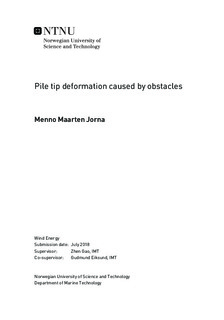Pile tip deformation caused by obstacles
Master thesis
Permanent lenke
http://hdl.handle.net/11250/2571138Utgivelsesdato
2018Metadata
Vis full innførselSamlinger
- Institutt for marin teknikk [3431]
Sammendrag
To identify the pile tip deformation, a finite element model is established. Six volume elements over the thickness are required at the contact zone to model the pile-boulder interaction accurately. Axial- and lateral soil support is included in the model by using non-linear Winkler springs. Lateral soil support inside the pile is included by transferring the results of a volume element model into linear springs.
A parametric study is performed to investigate the influence of different parameters on damage to the pile tip. It is noticed that a fully geometric- and material nonlinear analyses is required to performs these simulations. Also, it is shown that in contrast with what is frequently done and also mentioned in design standards, the D/t ratio of the pile cannot be used as single parameter to design monopiles. Both D and t should be independently taken into account. Furthermore, it is seen that relatively large pile-boulder contact angles or low steel-rock friction causes the pile to slip over the boulder s surface. Higher friction or smaller contact angles are likely to result in rippling or local in- or outward (local ovalisation) deformation of the wall. Although the larger contact angles and lower friction causes the pile to slip over the boulder s surface, the horizontal reaction is shown to be large enough to push the boulder away, reducing the damage to the tip.
Based on a pile drive-ability analyses it is pointed out that current offshore hydraulic hammers are able to deliver the load that is needed to initiate the investigated local tip damage. Furthermore, based on Terzaghi's bearing formulation and the Brazilian Tensile Test it is demonstrated that local penetration of the pile into the boulder is likely to happen for softer rocks and that splitting the boulder is not likely to occur. Finally, one dynamic simulation is run to compare the static and dynamic simulation. It seems possible to investigate failure mechanisms using statics. Accurate results and propagation should be obtained in dynamic analyses. Detailed dynamic analyses is left for future work.
